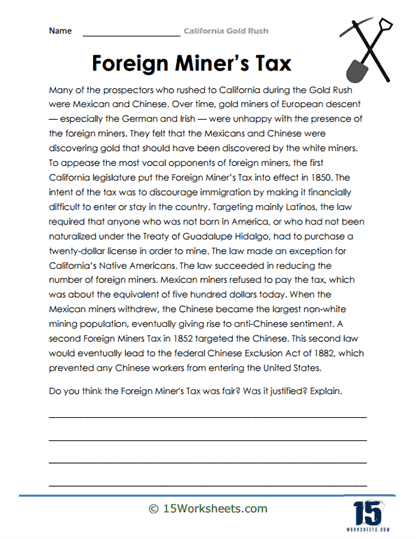Foreign Miner’s Tax

Worksheet Description
This worksheet looks into the complexities surrounding the taxes imposed on foreign miners during the California Gold Rush. It highlights the discontent among European-descended miners towards Mexican and Chinese gold miners and describes how the Foreign Miner’s Tax was implemented in 1850 to curb the influx of Latinx and Asian miners. The worksheet underscores the socio-economic and racial motivations behind the tax, detailing its ramifications, especially on the Chinese community, which eventually led to the federal Chinese Exclusion Act of 1882, barring Chinese workers from entering the U.S.
To engage with this worksheet, students should start by reading the provided text carefully to understand the historical context and nuances of the Foreign Miner’s Tax. After comprehending the primary motivations behind the tax and its effects on different communities, students should reflect on the questions posed at the end. Using evidence from the text and their own knowledge or external sources, they can then form an opinion on the fairness and justification of the tax. It’s crucial for students to provide well-reasoned arguments and cite specific evidence from the passage to support their viewpoint.
The primary aim of this worksheet is to enlighten students about the intersection of economic, racial, and legislative issues during the California Gold Rush era. It seeks to instill critical thinking skills by prompting students to question and evaluate the fairness and motivations behind historical policies. By juxtaposing economic interests with racial biases, the worksheet encourages students to recognize the profound societal implications that can stem from legislative decisions. Furthermore, the exercise fosters empathy and understanding by exposing students to the challenges faced by marginalized communities in historical contexts.
